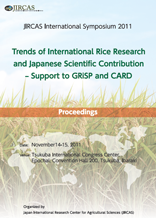Genomics-Assisted Allele Mining and its Integration to Breeding in Rice

Since whole genome sequence of rice has been decoded, it has been more than 6 years. Rice sequence
information has contributed on innovation of selection strategy in rice breeding (marker assisted selection) as
well as functional analysis of rice genes. Elucidation of the association between nucleotide and phenotypic
changes is inevitable to this end and has been a big challenge in molecular genetics and breeding of rice.
Toward this goal, we have been involved in the genetic dissection of natural phenotypic variations in rice and
have identified several genes involved in complex traits, including heading date, pre-harvest sprouting, root
morphology, disease resistance and eating quality. To enhance the power of genetic dissection of complex
phenotypes, we are developing several mapping populations, such as recombinant inbred lines and
chromosome segment substitution lines, which will allow us to extract the useful alleles from natural variants.
Recently, QTL for durable resistance to rice blast has been cloned from Japanese upland rice. This finding has
opened new opportunity to introduction of the unique blast resistance gene without a linkage drag of low
eating quality. We have also detected a major QTL for deeper rooting on chromosome 9. Based on the MAS,
near-isogenic lines of IR64 with deeper root has been developed and is now under evaluation of its potential
of drought avoidance. To facilitate allele mining using novel plant materials, we have also embarked on the
genome-wide discovery of single nucleotide polymorphisms (SNPs). These SNP explore new strategy of
genetic and breeding study. We have already revealed genomic sequences of several cultivars to detect SNP
and definition of haplotype block of Japanese rice cultivars and high-yielding cultivars for forage use.
Currently association between these particular haplotypes and phenotypic performance is investigated. These
progresses have gradually acted as a force to change a landscape of selection in rice breeding.
| Date of issued | |
|---|---|
| Creator | Masahiro Yano Yusaku Uga Shuichi Fukuoka Kaoru Ebana Jun-ichi Yonemaru Toshio Yamamoto |
| Subject |
Single nucleotide polymorphism (SNP) marker assisted selection quantitative trait locus (QTL) mapping population |
| Publisher | Japan International Research Center for Agricultural Sciences |
| Available Online | |
| Issue | 2011 |
| spage | 63 |
| epage | 67 |
| Rights | Japan International Research Center for Agricultural Sciences |
| Language | eng |
